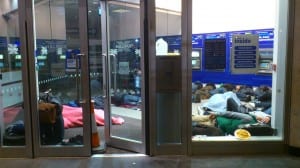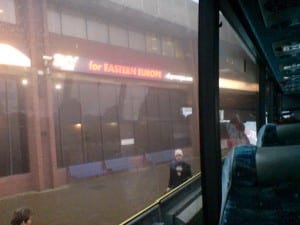Storming the Winter Palace
By Sarah J Young, on 20 December 2013
Storming the Winter Palace, a SSEES languages and culture photo competition on the theme of Russian and East European London, led students and staff to contemplate cultural resonances, contemporary identities and stereotypes – and language-learning opportunities! In the final post of the year on the SSEES Research Blog, Sarah Young introduces a selection of entries. Commentaries are by the photographers, unless otherwise stated.
Harbry Ellerby’s photograph of the Hungarian stall in Camden reminds Eszter Tarsoly that every encounter with Eastern European food in London invites us to reflect on cultural exchange, language, and translation:
The photographer took this shot in front of the Hungarian stall in Camden Town. The food on sale here, instead of the grilled sausages more usual on Polish and other East European stands, is lángos, a deep-fried flat bread whose dough is similar to that of pizza. It is traditionally seasoned with garlic and tejföl, a wide-spread diary product in Eastern Europe known in various guises in the region (e.g. Romanian smântână and Czech smetana) and most similar perhaps to soured-cream. How much a simple, hearty food – particularly recommended after a long, hearty night – can teach us about translation! The man’s silouette in front of the stall and the hanging flower baskets are revealing: the image, while entirely authentic, could have been taken only on a somewhat manicured market. This video clip of the song ’Lángos, tejföl’ by the band Kaukázus shows how lángos is enjoyed in Hungary.
Seeing a street sign commemorating one of the many Eastern European revolutionaries who lived in London during the nineteenth century, Eszter Tarsoly‘s thoughts turn to today’s immigrants:
In a quiet, respectable, yet exhilarating corner of Greenwich stretches a modest Cul-de-Sac called Kossuth Street, named after Hungary’s larger-than-life revolutionary hero, one of the driving forces behind the 1848-49 Revolution and War of Independence. Lajos Kossuth, after the demise of that Revolution, resided briefly in Britain, and legend has it that he stunned English-speaking audiences with his knowledge of English acquired in prison, or rather, with the kind of English he had acquired (only from written texts) in prison. We do not know exactly what Kossuth’s English was like. But not far from Kossuth Street, just across the Thames near Limehouse basin, there are entire blocks of flats inhabited almost exclusively by Kossuth’s contemporary compatriots, sharing overcrowded accommodation, having little hope – in the absence of knowing good English or who knows what other skills – to move on. A dead end…?
The reality of contemporary immigration from Eastern Europe is the subject of the first of two photographs by Ger Duijzings:
This image was taken during a cold night in February 2012 at just after 3 in the morning, at a bank branch opposite Victoria Station. Together with my research student Cezar Macarie I was doing a night walk around the area. Underneath a row of ‘fast, easy, and convenient’ cashpoints, in the glass protected bank area, a dozen or so Poles and Romanians are sleeping rough. As it is outside of official opening hours, the automatic door is kept open by a traffic cone. A Pole smoking a cigarette in front told us that he had been working in London for seven years, the first five years on a contract, but the last two working on-and-off.
Ger Duijzings’ second entry confronts insular British views of Europe and the question of what ‘Eastern Europe’ means in this country:
A quick snap shot taken at the end of November 2007 at Luton Airport which shows how outdoor advertising at UK airports targets low-budget travellers from East Europe. I had just returned from one of my frequent commutes to so-called ‘Eastern’ Europe which for some natives in the British isles apparently starts just across the North Sea. I took the photo from the inside of a bus waiting to take me into Central London. A lone individual is about to put his luggage into the belly of a bus: it may have been an East European guest worker or student, perhaps. The cold and grey image has the impersonal and slightly gloomy quality of what Marc Augé would call a ‘non-place’.
 Close
Close





